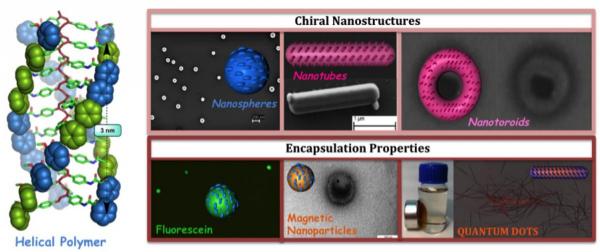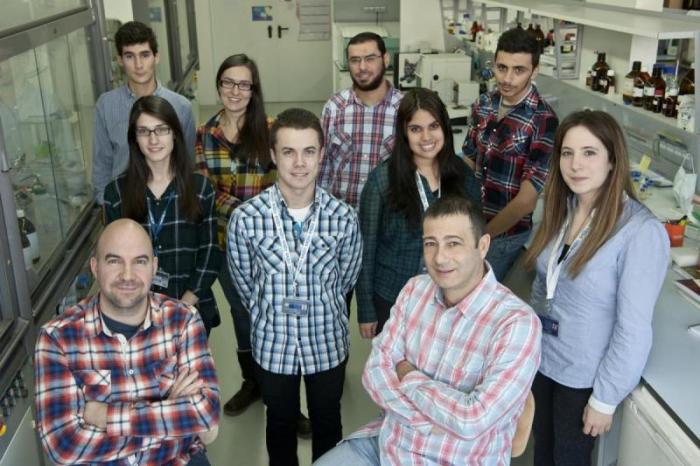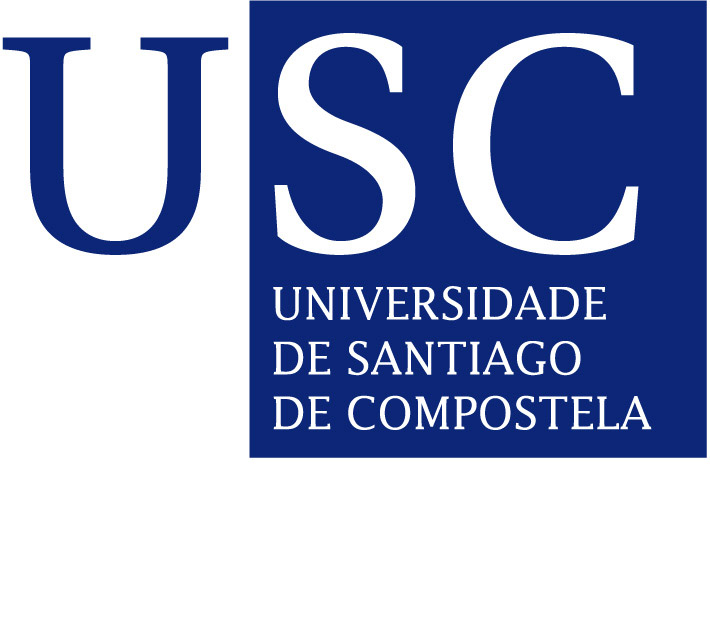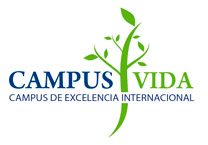La prestigiosa revista Angewandte Chemie publica en su último número un trabajo realizado por investigadores del Grupo Nanobiomol (Universidad de Santiago de Compostela). En él se describe un nuevo protocolo para obtener diferentes tipos de nanoestructuras a partir de un único polímero helicoidal y ciertas sales metálicas. Este trabajo ha sido seleccionado como portada de la revista Angewandte Chemie, que reconoce investigaciones de la máxima calidad en el campo de la química.
Ver vídeo divulgativo
 Los polímeros helicoidales empleados en este trabajo son los poli(fenilacetileno)s, unas macromoléculas que presentan como característica sobresaliente que su sentido de giro helicoidal se puede ajustar por la acción de diversos estímulos externos tales como temperatura, polaridad o iones metálicos. En consecuencia, estos polímeros actúan como sensores.
Los polímeros helicoidales empleados en este trabajo son los poli(fenilacetileno)s, unas macromoléculas que presentan como característica sobresaliente que su sentido de giro helicoidal se puede ajustar por la acción de diversos estímulos externos tales como temperatura, polaridad o iones metálicos. En consecuencia, estos polímeros actúan como sensores.

Esta investigación ha sido llevada a cabo por Felix Freire (investigador Ramón y Cajal) y Sandra Arias (investigadora predoctoral), miembros del Grupo de Investigación de Emilio Quiñoá y Ricardo Riguera, también co-autores del trabajo. El grupo Nanobiomol es pionero en la síntesis de nuevas nanoestructuras quirales siguiendo novedosos planteamientos a través de métodos químicos en disolución.
NANOBIOMOL ha publicado otros resultados relacionados en este actual campo de investigación en revistas científicas de prestigio como The Journal of the American Chemical Society y Chemical Science (Royal Chemical Society). Estos artículos también se han sido destacados como portadas de esas revistas. Actualmente, el Grupo sigue trabajando en la generación de nuevas nanoestructuras.
Nota Técnica
 The interaction of a highly dynamic poly(aryl acetylene) (poly-1) with Li+, Na+, and Ag+ leads to macroscopically chiral supramolecular nanospheres, nanotubes, toroids, and gels. With Ag+, nanospheres with M helicity and tunable sizes are generated, which complement those obtained from the same polymer with divalent cations. With Li+ or Na+, poly-1 yields chiral nanotubes, gels, or toroids with encapsulating properties and M helicity. Right-handed supramolecular structures can be obtained by using the enantiomeric polymer. The interaction of poly-1 with Na+ produces nanostructures whose helicity is highly dependent on the solvation state of the cation.
The interaction of a highly dynamic poly(aryl acetylene) (poly-1) with Li+, Na+, and Ag+ leads to macroscopically chiral supramolecular nanospheres, nanotubes, toroids, and gels. With Ag+, nanospheres with M helicity and tunable sizes are generated, which complement those obtained from the same polymer with divalent cations. With Li+ or Na+, poly-1 yields chiral nanotubes, gels, or toroids with encapsulating properties and M helicity. Right-handed supramolecular structures can be obtained by using the enantiomeric polymer. The interaction of poly-1 with Na+ produces nanostructures whose helicity is highly dependent on the solvation state of the cation.
Therefore, structures with either of the two helicities can be prepared from the same polymer by manipulation of the cosolvent. Such chiral nanotubes, toroids, and gels have previously not been obtained from helical polymer–metal complexes. Chiral nanospheres made of poly(aryl acetylene) that were previously assembled with metal(II) species can now be obtained with metal(I) species.
Grupo de Investigación: http://www.usc.es/ciqus/en/groups/nanobiomol
Portada: http://onlinelibrary.wiley.com/doi/10.1002/anie.v53.50/issuetoc
Artículo científico: http://onlinelibrary.wiley.com/doi/10.1002/anie.201406884/abstract


